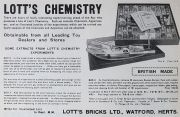Lotts Bricks
of Watford, Herts. Telephone: Watford 643. (1922)
Ditto Address. Telephone: Watford 1583-84. Cables: "Briques, Watford". (1929)
of 26-30 Vale Road, Watford, Herts. Telephone: Watford 5583. Cables: "Watford, England". (1947)
The English manufacturer E. A. Lott decided to buy the plant of the most well-known German manufacturer of construction toys, Richter, who made Anker blocks. He had devised a new system of bricks suitable for assembling small buildings. (See note below).
Lott was advised by the architect Arnold Mitchell on how to cut the bricks into shapes that could be used to make all kinds of buildings, from cottages to cathedrals.
1918 Together with a cardboard roof and instructions he started selling them as Lott's Bricks. Lott's success was assured when Queen Mary bought a set from him at the British Industries Fair in 1918. Lott produced a number of sets, each with its own series such as Modern, Lodomo and Tudor. The bricks were the last of the old fashioned composition blocks which were to be superseded by the very different styles exemplified by Minibrix, Bayko and Lego.
1922 Listed Exhibitor - British Industries Fair. Manufacturers of Toy Building Bricks of Artificial Stone for the erection of Houses, Bridges, Churches, Bungalows, Towers, etc., designed throughout by Mr. Arnold Mitchell, Architect. (Stand No. F.59) [1]
1929 Listed Exhibitor - British Industries Fair. Manufacturers of Lott's Bricks and Tudor Blocks, two delightful series of artificial stone Toy Bricks. An endless variety of model buildings can be constructed, including Old English half-timbered houses, etc. (Stand No. D.8) [2]
1947 Listed Exhibitor - British Industries Fair. Manufacturers of Toy Building Bricks in Plastic and Stone. Toy Chemistry Sets, Students Chemical Cabinets. Also Puzzles, Alphabet Blocks, Mosaic Sets, Kindergarten Blocks and true to scale constructional. Models in all stone. (Olympia, 2nd Floor, Stand No. J.2272) [3]
1960s Lott's Bricks Limited ceased to exist.
Notes
AH writes: "E. A. Lott did not buy any 'plant' from Richter. Richter never had a production facility in the UK. E. A. Lott set up his own factory from scratch in Vale Road, Bushey. His 'English' brick system filled a gap in the market due to the unavailabilty of imported Richter products during the war. This fact can be confirmed by reference to Bushey Museum, the Bayko Collectors' Club or to surviving members of the Lott's family. Sadly the myth of E. A. Lott acquiring plant or a factory from Richter has been repeated a number of times in publications or on websites."
See Also
- [1] V and A Museum of Childhood








